
The premier of the State Council of the People's Republic of China, commonly called the premier of China, is the head of government of China and leader of the State Council. The premier is the second-highest ranking person in China's political system, under the general secretary of the Chinese Communist Party /president, and holds the highest rank in the civil service of the central government.
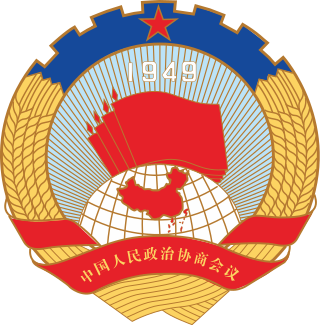
The Chinese People's Political Consultative Conference is a political advisory body in the People's Republic of China and a central part of the Chinese Communist Party (CCP)'s united front system. Its members advise and put proposals for political and social issues to government bodies. However, the CPPCC is a body without real legislative power. While consultation does take place, it is supervised and directed by the CCP.
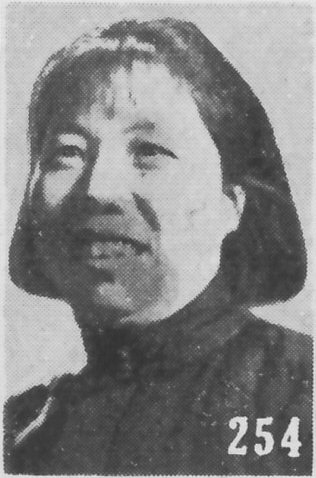
Deng Yingchao was the Chairwoman of the Chinese People's Political Consultative Conference from 1983 to 1988, a member of the Chinese Communist Party, and the wife of the first Chinese Premier, Zhou Enlai.
The orders of precedence in China is the ranking of political leaders in China for the purposes of event protocol and to arrange the ordering of names in official news bulletins, both written and televised. It is also sometimes used to assess perceived level of political power. Although there is no formally published ranking, there is usually an established convention and protocol, and the relative positions of Chinese political figures can usually be deduced from the order in meetings and especially by the time and order in which figures are covered by the official media. Since 1982, the General Secretary of the Chinese Communist Party has been the highest ranking official in the People's Republic of China (PRC).

The Revolutionary Committee of the Chinese Kuomintang (RCCK), also commonly known, especially when referenced historically, as the Left Kuomintang or Left Guomindang, is one of the eight minor political parties in the People's Republic of China under the direction of the Chinese Communist Party.
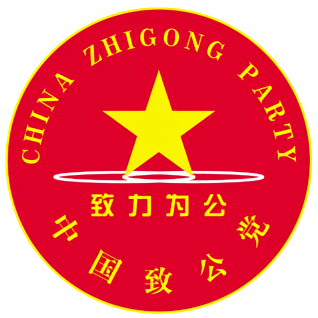
The China Zhi Gong Party is one of the eight minor political parties in the People's Republic of China under the direction of the Chinese Communist Party. It is the sixth-ranking minor party in China.
The 7th Central Committee of the Chinese Communist Party was in session from 1945 to 1956. It was a product of the convening of the 7th National Congress of the Chinese Communist Party. It held six plenary sessions in this 11-year period. It began in June 1945, before the end of the Second Sino-Japanese War, and the resumption of the Chinese Civil War. This committee would be succeeded by the 8th Central Committee.
The Constitutional history of the People's Republic of China describes the evolution of its Constitutional system. The first Constitution of the People's Republic of China was promulgated in 1954. After two intervening versions enacted in 1975 and 1978, the current Constitution was promulgated in 1982. There were significant differences between each of these versions, and the 1982 Constitution has subsequently been amended several times. In addition, changing Constitutional conventions have led to significant changes in the structure of the Chinese government in the absence of changes in the text of the Constitution.

Saifuddin Azizi was a Chinese politician who occupied several top positions in the government of the People's Republic of China (PRC). An ethnic Uyghur, he is most well-known for serving as the first chairman of the Xinjiang Uyghur Autonomous Region. Before the proclamation of the PRC in 1949, he served in the government of the breakaway Second East Turkestan Republic, as Minister of Education.

The national flag of the People's Republic of China, also known as the Five-star Red Flag, is a Chinese red field with five golden stars charged at the canton. The design features one large star, with four smaller stars in an arc set off towards the fly. It has been the national flag of China since the foundation of the People's Republic of China on 1 October 1949. The flag was designed by Zeng Liansong.
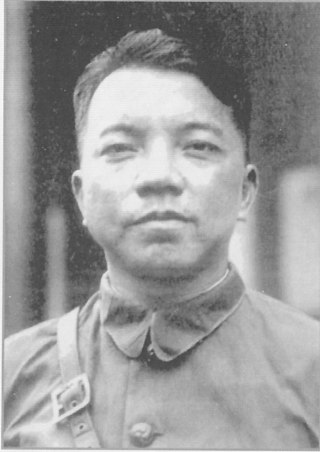
Li Jishen or Li Chi-shen was a Chinese military officer and politician, general of the National Revolutionary Army of the Republic of China, Vice President of the People's Republic of China (1949–1954), Vice Chairman of the National People's Congress (1954–1959), Vice Chairman the Chinese People's Political Consultative Conference (1949–1959) and founder and first Chairman of the Revolutionary Committee of the Kuomintang (1948–1959).

Li Xuefeng was a Chinese Communist politician. He occupied several prominent regional offices prior to the founding of the People's Republic in 1949. In 1960 he became the first political commissar of the Beijing Military Region. He took over the Beijing party organization as its First Secretary after the purge of Peng Zhen in May 1966, and was sent to take the reins of Hebei's Revolutionary Committee between 1968 and 1971. However, his support for Chen Boda during the 1971 Lushan Conference led him to be branded as a supporter of Lin Biao; he was purged and sent into internal exile in Anhui province for eight years. He was politically rehabilitated in 1982, and went on to serve in several advisory positions in the party.
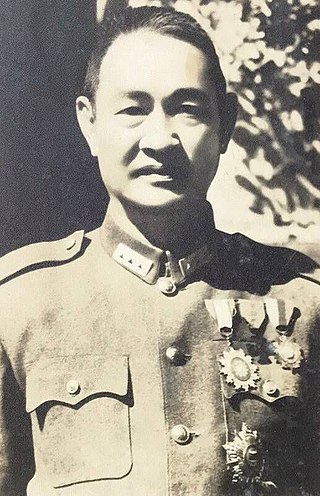
Cheng Qian was a Chinese army officer and politician who held very important military and political positions in both the Republic of China and the People's Republic of China. Educated at the Imperial Japanese Army Academy and Waseda University, he first met Sun Yat-sen in Tokyo, becoming an early supporter. Later, under Chiang Kai-shek, he was one of the most powerful members of the Kuomintang, notably serving as Chief of Staff of the Military Affairs Commission during the Second Sino–Japanese War.

The chairman of the National Committee of the Chinese People's Political Consultative Conference is the leader of the National Committee of the Chinese People's Political Consultative Conference (CPPCC), which is a political advisory body in the People's Republic of China.

The National People's Congress (NPC) is the highest organ of state power of the People's Republic of China. The NPC is the only branch of government in China, and per the principle of unified power, all state organs from the State Council to the Supreme People's Court (SPC) are subservient to it. With 2,977 members in 2023, it is the largest legislative body in the world. The NPC is elected for a term of five years. It holds annual sessions every spring, usually lasting from 10 to 14 days, in the Great Hall of the People on the west side of Tiananmen Square in Beijing.
People's democratic dictatorship is a phrase incorporated into the Constitution of the People's Republic of China and the Constitution of the Chinese Communist Party. The premise of the "People's democratic dictatorship" is that the Chinese Communist Party (CCP) and state represent and act on behalf of the people, but in the preservation of the dictatorship of the proletariat, possess and may use powers against reactionary forces. The term forms one of the CCP's Four Cardinal Principles. Implicit in the concept of the people's democratic dictatorship is the notion that dictatorial control by the party is necessary to prevent the government from collapsing into a "dictatorship of the bourgeoisie", a liberal democracy, which, it is feared, would mean politicians acting in the interest of the bourgeoisie. This would be in opposition to the socialist charter of the CCP.
Shi Taifeng is a Chinese politician currently serving as the head of the United Front Work Department (UFWD) of the Central Committee of the Chinese Communist Party (CCP) and the first-ranking vice chairperson of the Chinese People's Political Consultative Conference (CPPCC). He is additionally a member of the CCP Politburo and a secretary of the CCP Secretariat.
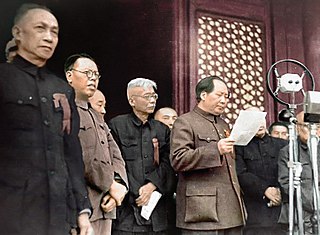
The proclamation of the People's Republic of China was made by Mao Zedong, the Chairman of the Chinese Communist Party (CCP), on October 1, 1949, in Tiananmen Square in Beijing. The government of a new state under the CCP, formally called the Central People's Government, was proclaimed by Mao at the founding ceremony.

The 14th National Committee of the Chinese People's Political Consultative Conference is the current meeting of the top political advisory body of the People's Republic of China. It convened in Beijing, on 4 March 2023, and is scheduled to continue until March 2028.

The Political Consultative Conference (PCC) was a conference held on 10–31 January 1946 in the Republic of China between the Kuomintang (KMT) and the Chinese Communist Party (CCP) to create a coalition government. The PCC was convened as part of the Double Tenth Agreement between the KMT and the CCP. The conference ultimately ended in failure.
















